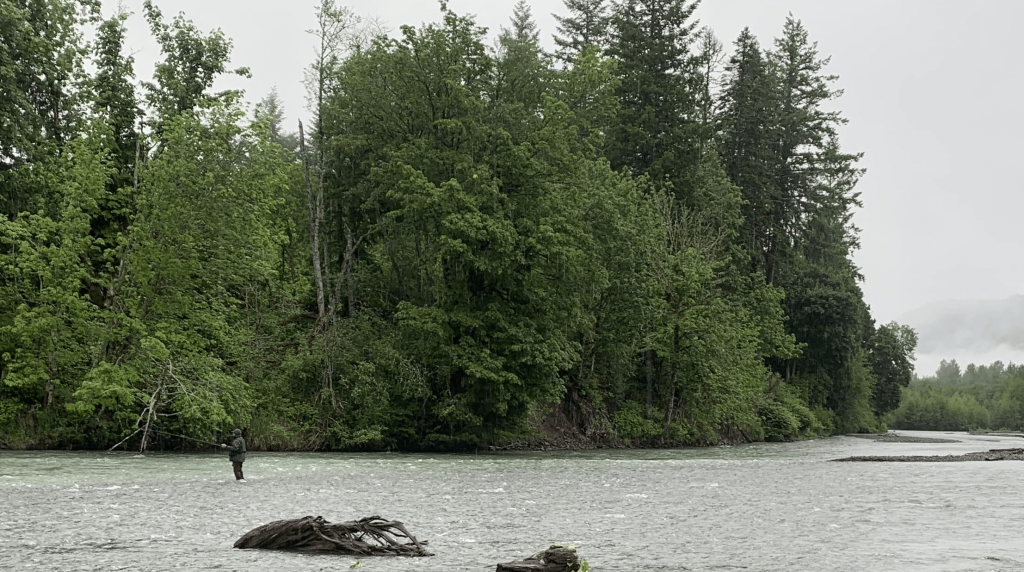
New North Fork Nooksack Springer Fishery, Recovery Collaboration Touted
They’re not creating any new rivers these days, but sometimes old rivers host renewed fishing opportunities.
WDFW is touting a joint state-tribal effort that in part brought spring Chinook fishing back to a Mt. Baker-area river after a 66-year absence and put nearly 220 hatchery fish on barbecues for sport anglers.

The agency says that it and local tribes have been working to rebuild the North Fork Nooksack’s springer run, and following salmon season negotiations with the comanagers at North of Falcon this year, 10 miles of the river was opened for the first time since 1954.

“Without the collaboration of the treaty tribes in the Nooksack River basin we wouldn’t have been able to offer this fishery,” said Edward Eleazer, WDFW’s North Sound regional fish manager, in a press release. “It’s an incredible testament to our work together to improve Chinook salmon populations and support orca recovery — and brings an added bonus for recreational anglers.”

Call it a silver lining to a very contentious NOF that saw key North Sound salmon opportunities cut, but WDFW estimates that the inaugural season saw 87 adult hatchery kings and 131 hatchery jacks kept, with seven clipped adults and 77 jacks released.
Fishing was open from the Highway 9 bridge to markers near WDFW’s Kendall Creek Hatchery from June 1-30, and it was monitored to ensure impacts on wild Chinook weren’t exceeded.
“Most popular method was drift fishing eggs under a float,” reported spokeswoman Eryn Couch. “However there were also anglers that tried spinners, shrimp, and a few fly fishers gave it a shot too.”
Before he retired, longtime local biologist Brett Barkdull said he’d heard that twitching jigs yielded a few too.
Nine wild adults and seven wild jacks were also released.
Overall, anglers spent 7,600 hours trying to catch kings on the river east of Bellingham. Including jacks as well as natives that were released, it equates to around 23 hours a fish, slow angling.
But even if effort and catch are drops in the bucket compared to springers on the Columbia at the other end of I-5 in Western Washington, it also represents a new fishery in a region that has suffered a reduction of opportunities over the years.

“General sentiment was anglers were happy to be on the water enjoying a new spring Chinook opportunity,” said Couch.
Nooksack springers are also a “critical” stock for Puget Sound’s southern resident orcas and hatchery production was increased from 800,000 to 1.3 million smolts at Kendall Creek in 2018, while the Lummi Nation’s Skookum Creek Hatchery on the South Fork Nooksack has reared as many as 1.6 million and plans to let 2 million go.
As of the latest WDFW hatchery escapement report, 1,270 adults that returned to Kendall so far this year yielded the eggtake goal for the season and then some. Past years have seen as many as 2,908 return.
Assuming good ocean conditions, the extra half million smolts out of Kendall may boost fishing in a couple years, though state managers might also push the opener earlier. Word was that some returning fish were a bit colored in June.
Meanwhile, the Lummi Nation and Nooksack Tribe say habitat issues are limiting recovery of wild Chinook in the Nooksack system, but are working on addressing those.


“Working together will provide more fishing opportunity for everyone,” said Gerald James, Lummi senior ESA policy analyst, in the WDFW press release. “We are focusing on what we can actually accomplish instead of what we wish we could do. The 10-year management plan for the watershed that we signed last year with WDFW is working well with agreed goals and outcomes.”
